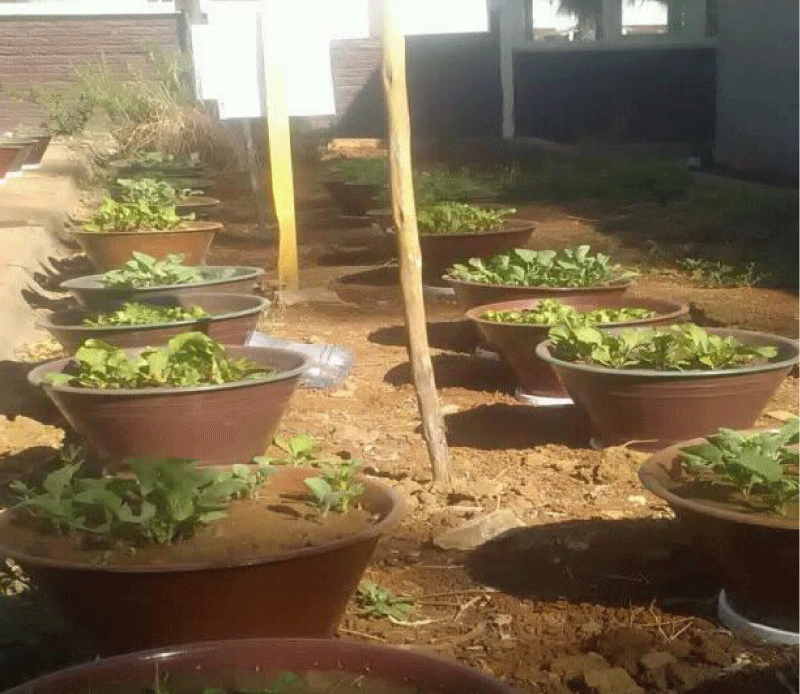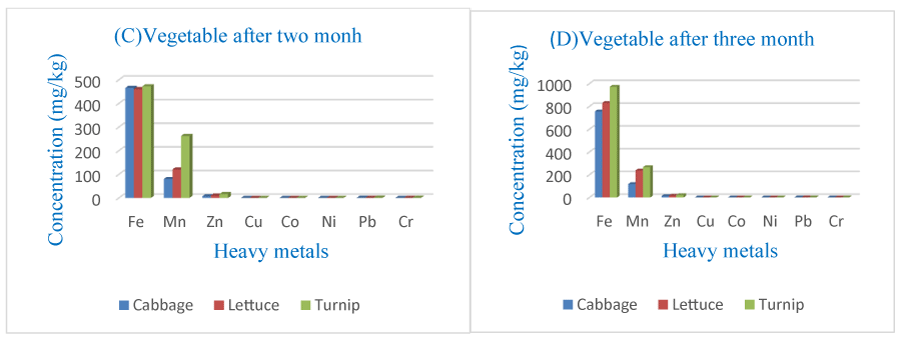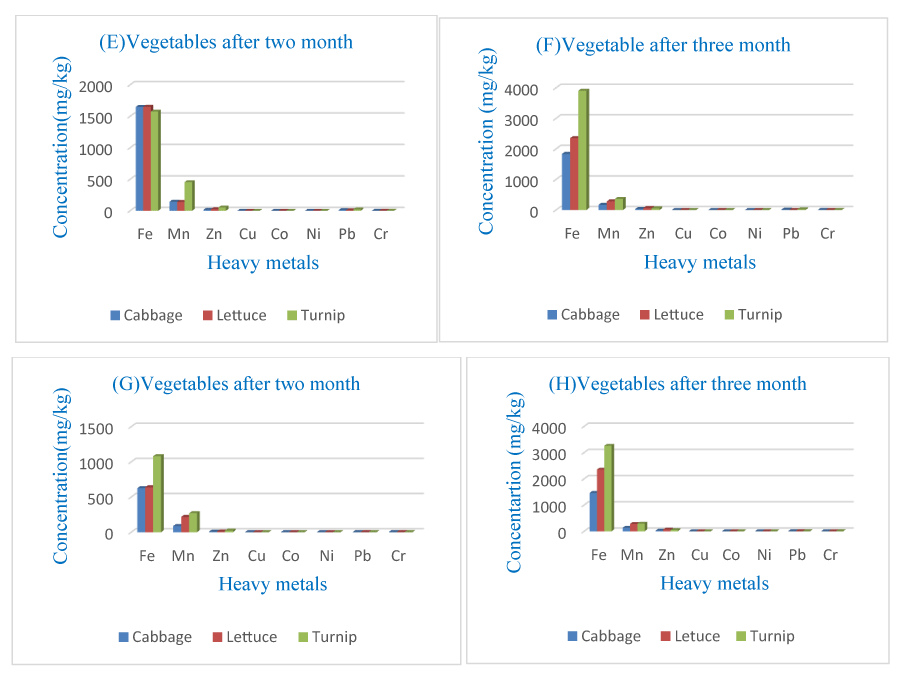Annals of Environmental Science and Toxicology
Effect of Water and Soil Contamination by Heavy Metals in Lettuce (Lactuca sativa), Cabbage (Brassica oleracea var. capitate), and Turnip (Brassica napus L.) at Different Stage
Nibret Mekonen* and Girum Habte
Cite this as
Mekonen N, Habte G (2022) Effect of Water and Soil Contamination by Heavy Metals in Lettuce (Lactuca sativa), Cabbage (Brassica oleracea var. capitate), and Turnip (Brassica napus L.) at Different Stage. Ann Environ Sci Toxicol 6(1): 035-040. DOI: 10.17352/aest.000050Copyright
© 2022 Mekonen N, et al. This is an open-access article distributed under the terms of the Creative Commons Attribution License, which permits unrestricted use, distribution, and reproduction in any medium, provided the original author and source are credited.Environmental pollution with heavy metals is very harmful to the human body and other life forms, even in low concentrations, as there is no effective removal mechanism. Urban agriculture utilizes this contaminated land for the cultivation of vegetable crops to facilitate their food security and entry of toxic heavy metals into the food chain. The objective of this study was to evaluate the impact of contaminated soil and water with heavy metals on the quality of vegetable crops at different growth ages. Microwave Plasma Atomic Emission Spectrometry (MP-AES) was used to determine the concentration of these heavy metals. The concentration of heavy metals (Fe, Mn, Zn, Cu, Co, Ni, Pb, and Cr) in contaminated soil was found to be 39434.9±30.0, 3183.7±43.5, 222.0±10.2, 22.28±2.5, 0.057±0.00, 5.8±0.03, 72.72±0.01, 148.6±15 mg/kg, respectively. In addition, the mean concentration of Fe, Mn, Zn, Cu, Co, Ni, and Cr in wastewater was found to be 5.2±0.5, 0.8±0.08, 0.72±0.01, 1.05±0.03, 0.01±0.00, 0.2±00, 0.72±0.01 and 0.14±0.02, respectively. The relative abundance of heavy metal in soil, water and vegetable samples were in the following order: Fe >Mn >Zn > Cr > Pb> Cu> Ni> Co, Fe > Cu > Mn >Zn =Pb> Ni > Cr > Co and Fe >Mn >Zn > Pb > Cu> Cr > Ni> Co, respectively, and the accumulation of heavy metals in three month growth. All lettuce, cabbage, and turnip vegetables grew faster than two months. Both two and three months of age, the accumulation of heavy metals in turnips > lettuce > cabbage. Most of the soil, water, and vegetable samples exceeded the permissible limit of heavy metals prescribed by the World Health Organization (WHO) standards.
Abbreviations
PW: Pure Water; PWCS: Pure Water Contaminated Soil; PS: Pure Soil; CWPS: Contaminated Water Pure Soil and CWCS: Contaminated Water Contaminated Soil
Introduction
Environmental pollution with heavy metals has become a major concern in the world due to urbanization, industrialization, high population density, improved living conditions, and economic development [1]. A large amount of organic and inorganic pollutants, mostly toxic heavy metals, are released into the environment either directly or indirectly as a result of natural or anthropogenic activity [2,3]. Heavy metals, such as mercury, chromium, cadmium, arsenic, nickel, lead, zinc, copper, cobalt, and manganese, are among the most dangerous industrial pollutants in water and soil [4]. Inorganic pollutants (toxic heavy metals) are not biodegradable, and their persistence and accumulation in living organisms pose a number of health and environmental risks [5,6]. Toxic heavy metals are very harmful to the human body and other life forms, even in low concentrations, as there is no effective removal mechanism [1,2]. Wastewater discharged from industries, particularly in developing countries like Ethiopia, is the major challenge of the present day. Much of the literature in Ethiopia indicate that wastewater discharged from different sources is above the permissible limits given by WHO and EPA [7,8]. Urban agriculture utilizes this waste and contaminated soil for the cultivation of vegetable crops to facilitate food security. Like in other cities in Addis Ababa, Ethiopian urban farmers irrigate vegetables such as lettuce (Lactuca sativa), cucumbers (Cucumis sativus), potatoes (Solanum tuberosum), cabbage (Brassica oleracea var. capitate), green onion (Allium porrum L.), turnips (Brassica napus L.), etc. for urban markets and their needs. Most toxic heavy metals accumulate in vegetables contaminated by contaminated water and soil. Apart from the health risk, heavy metal accumulation also affects the growth and yield of vegetable crops. The objective of this study is to determine the accumulation of heavy metals in lettuce (Lactuca sativa L.), turnip (Brassica napus L.), and cabbage (Brassica oleracea var. capitate) at different ages growing in the pot.
Materials and methods
Area of the study
This study (pot experiment) was conducted at the Ethiopian Institute of Agricultural Research (EIAR) in Addis Ababa, Ethiopia under environmental conditions. The pot experiment had four treatments such as pure water, pure soil, pure water contaminated soil, contaminated water pure soil, and contaminated water contaminated soil (PWS, PWCS, CWPS, and CWS), respectively.
Apparatus and instruments
A Multiwve 3000 microwave system (Anton Paar, Graz, Austria) programmable for time and power between 600 and 1400 W and equipped with 16 high-pressure polytetrafluoroethylene vessels (MF 100) and a 4100 MP-AES (Agilent, California, US) were used for the analysis of toxic heavy metals. The operating conditions of the instrument were forward plasma power of 1.0kW, nitrogen gas (spectral purity, 99.95%), and a flow rate of 16.0L/min (plasma), 1.2L/min (auxiliary), and 1.0L/min (nebulizer). The instrument was tuned for daily performance using the Elan 6100 DRC sensitivity detection limit solution (PerkinElmer Pure, USA).
Chemicals and reagents
The following chemicals were used: concentrated Hydrochloric Acid (HCl) 37% (Fluka, Germany), nitric acid (HNO3) 69% (Fluka), hydrogen peroxide (H2O2, 30%), hydrofluoric acid (HF, 70%) (Dong Woo Fine-Chem Iksan, Korea), and ultrapure deionized water (18.2 M.cm) (Millipore, Bedford, MA, USA). A 10mg/L multi-elemental standard solution from Ana Pure Kriat, Daejeon, Korea was used for preparing standards for calibration curves.
Sample collection for vegetable cultivation
Sample collection: The wastewater and contaminated soil were collected from the Akaki kality sub-city in Addis Ababa, and non-contaminated soil was collected from Debre Birhan in the Amhara region. A total of 4 vegetable seed samples, namely lettuce (Lactuca sativa L.), turnip (Brassica napus L.), and cabbage (Brassica oleracea var. capitate), were purchased from the paisa market, in Addis Ababa.
Sample cultivation: The vegetables (lettuce, turnip, and cabbage) were grown in pots using (PWS, PWCS, CWPS, and CWS) as follows Figure 1.
The vegetable samples were collected two or three months ago, washed with deionized water to remove unwanted material, sliced with a stainless steel knife, and dried. The dried samples were then homogenized and powdered in a grinder with titanium blades (MR 350 CA, Braun, Spain). The powdered samples were properly labeled and stored in plastic bags at 20°C (Micom CFD-0622, Samsung, Korea) for microwave digestion. The soil and water samples were prepared for digestion before and after the cultivation of the vegetable crops.
Procedures: The dried vegetable and soil samples were mechanically ground and weighted at approximately 0.5 g and added into a Teflon closed vessel, then 7.0 mL of concentrated HNO3 and 2.0 mL of H2O2 were added for vegetable samples [9] and 9.0 mL of concentrated HNO3 and 3.0 mL of HF were added for soil samples [10, 11], and digested by microwave-assisted digestion. The microwave-assisted digestion was set as follows to digest the samples: 1000W at 80°C for 5 min, 1000W at 50°C for 5min, 1000W at 190°C for 20min, and 0W for 30min for cooling. After cooling, the contents of the tubes were diluted to 50 mL with deionized water.
Analysis of the sample and quality assurance: Water, soil, and vegetable samples were analyzed using Agilent microwave plasma atomic emission spectrometers (MP-AES). Each metal or element has been measured using its wavelength. Analysis of the samples was performed by standard calibrations. Standard solutions were prepared with the same concentration of acids present in digested samples for all vegetables, water, and soil, by diluting a multi-elemental standard containing the analytes. Each sample was measured in triplicate. The accuracy, precision, and calibration curves of each metal concentration were performed by the standard reference materials. Calibration conditions: calibration correlation coefficient limit of 0.995, bank subtraction: on, stabilization time: 15 min, sample uptake time: 15 min, pump speed: 15rpm.
The Hazard Quotient (HQ)
The hazard quotient (HQ) is the ratio between the daily intake of vegetables (Div) and the reference oral dose (RfD). If the ratio is lower than 1, there will be no obvious risk [12]. An estimate of the potential hazard of metals to human health (HQ) through the consumption of vegetables is calculated as follows:
HQ = (Div) x (Cmetal)/RfD x Bo (1)
Where (Div) is the daily intake of vegetables (kg per day), (Cmetal) is the concentration of metal in the vegetable (mg/kg), RfD is the oral reference dose for the metal (mg/kg of body weight per day), and Bo is the human body mass (kg). The hazard quotient (HQ) indicates the health risk level due to exposure to pollutants [13].
Plant-to-soil transfer factor
The metal concentration in the extracts of soils and plants was calculated on the basis of dry weight. The plant Transfer Factor (TF) was calculated as follows:
TF = Cplant/CSoil (2)
Cplant and Csoil represent the toxic metal concentration in extracts of plants and soils on a dry weight basis, respectively.
Data examination
The obtained data were analyzed using one-way ANOVA and Minitab17 software. The results were reported within the 95% level of confidence or (p<0.05) significant difference level and mean ± standard deviation of each triplicated data point.
Results and discussion
The average concentration ±SD of each heavy metal in pure water, wastewater, pure soil, and contaminated soil samples collected from the two sites is given in Table 1. In addition, Tables 2,3 also show the mean ±SD concentration of heavy metals, mainly Fe, Mn, Zn, Cu, Co, Ni, Pb, and Cr in vegetable crops, namely lettuce, cabbage, and turnip, two and three months ago, respectively. The accumulation of these heavy metals in the mentioned vegetable plants or crops was different in the different treatments (PWS, PWCS, CWPS, and CWS), respectively Figures 2-4.
The concentration of heavy metals (Fe, Mn, Zn, Cu, Co, Ni, Pb, and Cr) in contaminated soil was found to be 39434.9±30.0, 3183.7±43.5, 222.0±10.2, 22.28±2.5, 0.057±0.00, 5.8±0.03, 72.72±0.01, 148.6±15mg/kg, respectively. The obtained values of these heavy metals are compared with different organizations and literature as shown in Table 4. The mean concentration of Fe, Cu, and Ni were found to be which are less than the results of Fe, Cu, and Ni (43317.8, 83.70, and 294.2), respectively found in Cuba [16]. Most of the concentrations of trace metals in waste or contaminated water in the study were found to be higher than the different organization permissible limits [17-20]. In addition, the mean concentration of Fe, Mn, Zn, Cu, Co, Ni, and Cr in pure water was found to be less than the WHO permissible limits [21] but the concentration of Pb was found to be higher than the WHO standards. The concentration of (Fe, Mn, Zn, Cu, Co, Ni, Pb, and Cr) metals in cabbage growing in CWP were found to be 2440.5±74.1, 183.0±39.5, 42.0±10.2, 4.5±0.04, ND, 1.5±0.01, 17.0±7.4 and 2.44±0.07, respectively. The concentration of (Fe, Mn, Zn, Cu, Co, Ni, Pb, and Cr) metals in lettuce growing in CWP were found to be, 3906.2±86.7, 522.3±92.6, 82.0±16.3, 5.7±0.08, ND, 1.5±0.03, 22.0±8.5 and 2.77±0.08, respectively. The concentration of (Fe, Mn, Zn, Cu, Co, Ni, Pb, and Cr) metals in turnip grow in CWP were also found to be, 3977.8±78.2, 485±75.7, 63.0±14.5, 5.84±0.08, ND, 1.52±0.04, 25.1±12.0 and 6.71±0.18, respectively. The results of these metals in cabbage, lettuce, and turnip were not in good agreement with the literature, which means the metal concentrations in cabbage lettuce, and turnips were found to be higher than the literature values [22,23].
Conclusion and recommendation
The accumulation of metal concentration in soil, water and vegetables in decreasing order is Fe >Mn >Zn > Cr > Pb> Cu> Ni> Co, Fe > Cu > Mn >Zn =Pb> Ni > Cr > Co and Fe >Mn >Zn > Pb > Cu> Cr > Ni> Co, respectively, and the accumulation of heavy metals in three month growth vegetables were found to be higher than two month growth in all lettuce, cabbage and turnip vegetables. At both two and three months of age, the accumulation of heavy metals in turnip > lettuce> cabbage. Soil-plant transfer factor of these metals in cabbage, lettuce, and turnip ranged from 0.01 to 0.34, which indicates most of the pollutants transferred from soil to plant than water to plants. This result indicates heavy metals had significant health risk effects to the consumer associated with the consumption of these vegetables, especially at the high maturity stage grown within contaminated areas. Therefore, we recommend that toxic heavy metals must be removed or reduced using different technologies before being discharged into the environment or there must be adulated treatments before and after releasing the waste from the sources.
The Ethiopian Institute of Agricultural Research’s directorate of food science and nutrition research has provided financial assistance for this project. The author wishes to convey their heartfelt gratitude for their assistance and contribution to the completion of this article.
- Ali H, Khan E (2017) Environmental chemistry in the twenty-first century. Environmental Chemistry Letters 15: 329-346. Link: https://bit.ly/3K1zKA9
- Ghosh AK, Bhatt MA, Agrawal HP (2012) Effect of long-term application of treated sewage water on heavy metal accumulation in vegetables grown in Northern India. Environ Monit Assess 184: 1025-1036. Link: https://bit.ly/3DGMmu3
- Wongrod S, Simon S, Guibaud G, Lens PN, Pechaud Y, et al. (2018) Lead sorption by biochar produced from digestates: Consequences of chemical modification and washing. Journal of Environmental Management 219: .277-284. Link: https://bit.ly/3J6lfK6
- Yu XL, He Y (2018) Optimal ranges of variables for an effective adsorption of lead (II) by the agricultural waste pomelo (Citrus grandis) peels using Doehlert designs. Scientific Reports 8: 729. Link: https://go.nature.com/38gdc0s
- De Agreda D, Garcia-Diaz I, López FA, Alguacil FJ (2011) Supported liquid membranes technologies in metals removal from liquid effluents. Review Materials 47: 146-168. Link: https://bit.ly/35BOuGW
- Sobukola OP, Adeniran OM, Odedairo AA, Kajihausa OE (2010) Heavy metal levels of some fruits and leafy vegetables from selected markets in Lagos, Nigeria. African Journal of Food Science 4: 389-393. Link: https://bit.ly/3NJ7iW3
- Muluken A, Haimanot G, Mesafint M (2013) Healthcare waste management practices among healthcare workers in healthcare facilities of Gondar town, Northwest Ethiopia. Health Science Journal 7: 315. Link: https://bit.ly/3LDWkiD
- Teshita A, Wondie A (2014) The impact of impoundment on downstream macro invertebrate communities at Koga Irrigation Dam, West Gojjam, Ethiopia. International Journal of Science Research 3: 2319-7064. Link: https://bit.ly/3KaHv6P
- Nogueira RA, Mingote RM, dos Santos EE, da Costa HF, Eugênia E (2011) Microwave digestion of vegetable samples for radiometric analysis. In 2011 International Nuclear Atlantic Conference–INAC 20-28. Link: https://bit.ly/37dhjKq
- Habte G, Choi JY, Nho EY, Jamila N, Khan N, e al. (2017) Determination of essential and toxic elements in tropical fruit by microwave-assisted digestion and inductively coupled plasma–mass spectrometry. Analytical Letters 50: 1025-1039. Link: https://bit.ly/3DADJBm
- Bettinelli M, Beone GM, Spezia S, Baffi C (2000) Determination of heavy metals in soils and sediments by microwave-assisted digestion and inductively coupled plasma optical emission spectrometry analysis. Analytical Chemical Acta 424: 289-296. Link: https://bit.ly/3uQapCV
- United States. Environmental Protection Agency. Office of emergency and remedial response, 1989. Risk Assessment Guidance for Superfund. Office of emergency and remedial response, US environmental protection agency.
- Chary NS, Kamala CT, Raj DSS (2008) Assessing risk of heavy metals from consuming food grown on sewage irrigated soils and food chain transfer. Ecotoxicol Environ Saf 69: 513-524. Link: https://bit.ly/379O76W
- Kinuthia GK, Ngure V, Beti D, Lugalia R, Wangila A, et al. (2020) Levels of heavy metals in wastewater and soil samples from open drainage channels in Nairobi, Kenya: Community health implication. Scientific Reports 10: 8434. Link: https://go.nature.com/3u4OjgG
- Fosu-Mensah BY, Addae E, Yirenya-Tawiah D, Nyame F (2017) Heavy metals concentration and distribution in soils and vegetation at Korle Lagoon area in Accra, Ghana. Cogent Environmental Science 3: 1405887. Link: https://bit.ly/35DcSYJ
- Alfaro MR, Montero A, Ugarte OM, do Nascimento CWA, de Aguiar Accioly AM, et al. (2015) Background concentrations and reference values for heavy metals in soils of Cuba. Environ Monit Assess 187: 4198. Link: https://bit.ly/3j0v6qa
- Aneyo IA, Doherty FV, Adebesin OA, Hammed MO (2016) Biodegradation of pollutants in waste water from pharmaceutical, textile and local dye effluent in Lagos, Nigeria. J Health Pollut 6: 34-42. Link: https://bit.ly/38kol0d
- Ayeni O (2014) Assessment of heavy metals in wastewater obtained from an industrial area in Ibadan, Nigeria. RMZ–M&G 61: 19-24. Link: https://bit.ly/3NHjNBz
- Ayers RS, Westcot DW (1985) Water Quality for Agriculture. Rome: food and agriculture organization of the United Nations 29: 174. Link: https://bit.ly/3J52iHx
- Rowe DR, Abdel-Magid IM (2020) Handbook of Wastewater Reclamation and reuse. CRC press. Link: https://bit.ly/3KcCLxC
- Edition F (2011) Guidelines for drinking-water quality. WHO Chronicle 38: 104-108. Link: https://bit.ly/35BOIOi
- Hou S, Zheng N, Tang L, Ji X (2018) Effects of cadmium and copper mixtures to carrot and pakchoi under greenhouse cultivation condition. Ecotoxicol Environ Saf 159: 172-181. Link: https://bit.ly/3LGqzW8
- Mohamed AE, Rashed MN, Mofty A (2003) Assessment of essential and toxic elements in some kinds of vegetables. Ecotoxicol Environ Saf 55: 251-260. Link: https://bit.ly/3NLUcYc
- Guerra F, Trevizam AR, Muraoka T, Marcante NC, Canniatti-Brazaca SG (2012) Heavy metals in vegetables and potential risk for human health. Scientia Agricola 69: 54-60. Link: https://bit.ly/35BniIi
- Song B, Lei M Chen T, Zheng Y, Yunfeng XIE, et al. (2009) Assessing the health risk of heavy metals in vegetables to the general population in Beijing, China. Journal of Environmental Sciences 21: 1702-1709. Link: https://bit.ly/3K6jlu5
- Rai PK Tripathi BD (2008) Heavy metals in industrial wastewater, soil and vegetables in Lohta village, India. Toxicological and Environmental Chemistry 90: 247-257. Link: https://bit.ly/3j2JApz
Article Alerts
Subscribe to our articles alerts and stay tuned.
 This work is licensed under a Creative Commons Attribution 4.0 International License.
This work is licensed under a Creative Commons Attribution 4.0 International License.





 Save to Mendeley
Save to Mendeley
